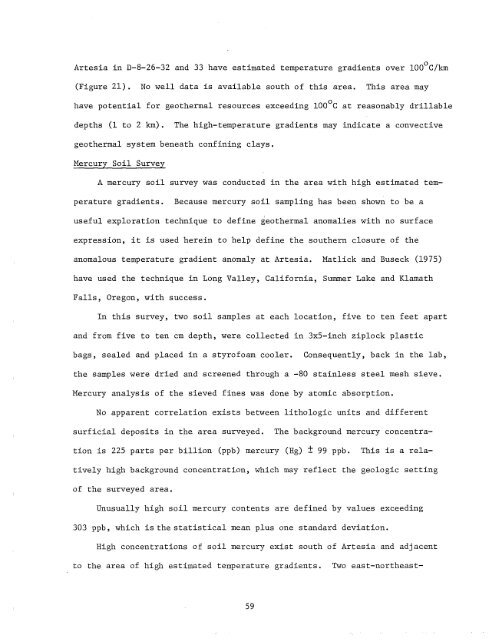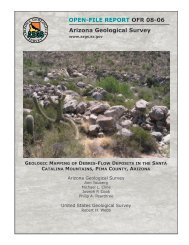geothermal resource potential of the safford-san simon basin, arizona
geothermal resource potential of the safford-san simon basin, arizona
geothermal resource potential of the safford-san simon basin, arizona
Create successful ePaper yourself
Turn your PDF publications into a flip-book with our unique Google optimized e-Paper software.
Artesia in D-8-26-32 and 33 have estimated temperature gradients over lOOoC!km<br />
(Figure 21). No well data is available south <strong>of</strong> this area. This area may<br />
have <strong>potential</strong> for <strong>geo<strong>the</strong>rmal</strong> <strong>resource</strong>s exceeding 1000C at reasonably drillable<br />
depths (1 to 2 km).<br />
The high-temperature gradients may indicate a convective<br />
<strong>geo<strong>the</strong>rmal</strong> system beneath confining clays.<br />
Mercury Soil Survey<br />
A mercury soil survey was conducted in <strong>the</strong> area with high estimated temperature<br />
gradients.<br />
Because mercury soil sampling has been shown to be a<br />
useful exploration technique to define <strong>geo<strong>the</strong>rmal</strong> anomalies with no surface<br />
expression, it is used herein to help define <strong>the</strong> sou<strong>the</strong>rn closure <strong>of</strong> <strong>the</strong><br />
anomalous temperature gradient anomaly at Artesia. Matlick and Buseck (1975)<br />
have used <strong>the</strong> technique in Long Valley, California, Summer Lake and Klamath<br />
Falls, Oregon, with success.<br />
In this survey, two soil samples at each location, five to ten feet apart<br />
and from five to ten cm depth, were collected in 3x5-inch ziplock plastic<br />
bags, sealed and placed in a styr<strong>of</strong>oam cooler.<br />
Consequently, back in <strong>the</strong> lab,<br />
<strong>the</strong> samples were dried and screened through a -80 stainless steel mesh sieve.<br />
Mercury analysis <strong>of</strong> <strong>the</strong> sieved fines was done by atomic absorption.<br />
No apparent correlation exists between lithologic units and different<br />
surficial deposits in <strong>the</strong> area surveyed.<br />
The background mercury concentration<br />
is 225 parts per billion (ppb) mercury (Hg) ± 99 ppb.<br />
This is a relatively<br />
high background concentration, which may reflect <strong>the</strong> geologic setting<br />
<strong>of</strong> <strong>the</strong> surveyed area.<br />
Unusually high soil mercury contents are defined by values exceeding<br />
303 ppb, which is <strong>the</strong> statistical mean plus one standard deviation.<br />
High concentrations <strong>of</strong> soil mercury exist south <strong>of</strong> Artesia and adjacent<br />
to <strong>the</strong> area <strong>of</strong> high estimated temperature gradients. Two east-nor<strong>the</strong>ast-<br />
59

















